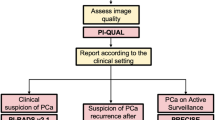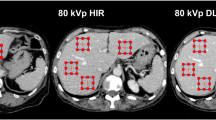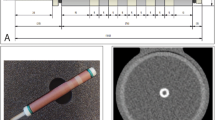Abstract
Objectives
To determine the diagnostic accuracy and image quality of ultra-low-dose computed tomography (ULDCT) with deep learning reconstruction (DLR) to evaluate patients with suspected urolithiasis, compared with ULDCT with hybrid iterative reconstruction (HIR) by using low-dose CT (LDCT) with HIR as the reference standard.
Methods
Patients with suspected urolithiasis were prospectively enrolled and underwent abdominopelvic LDCT, followed by ULDCT if any urinary stone was observed. Radiation exposure, stone characteristics, image noise, signal-to-noise ratio (SNR), and subjective image quality on a 5-point Likert scale were evaluated and compared.
Results
The average effective radiation dose of ULDCT was significantly lower than that of LDCT (1.28 ± 0.34 vs. 5.49 ± 1.00 mSv, p < 0.001). According to the reference standard (LDCT-HIR), 148 urinary stones were observed in 85.0% (51/60) of patients. ULDCT-DLR detected 143 stones with a rate of 96.6%, and ULDCT-HIR detected 142 stones with a rate of 95.9%. The urinary stones that were not observed with ULDCT-DLR or ULDCT-HIR were renal calculi smaller than 3 mm. There were no significant differences in the detection of clinically significant calculi (≥ 3 mm) or stone size estimation among ULDCT-DLR, ULDCT-HIR, and LDCT-HIR. The image quality of ULDCT-DLR was better than that of ULDCT-HIR and LDCT-HIR with lower image noise, higher SNR, and higher average subjective score.
Conclusions
ULDCT-DLR performed comparably to LDCT-HIR in urinary stone detection and size estimation with better image quality and decreased radiation exposure. ULDCT-DLR may have potential to be considered the first-line choice to evaluate urolithiasis in practice.
Key Points
• Ultra-low-dose computed tomography (ULDCT) has been investigated for diagnosis of urolithiasis, but stone evaluation may be adversely impacted by compromised image quality.
• This study evaluated the value of novel deep learning reconstruction (DLR) at ULDCT by comparing the stone evaluation and image quality of ULDCT-DLR to the reference standard of low-dose CT (LDCT) with hybrid iterative reconstruction (HIR).
• ULDCT-DLR performed comparably to LDCT-HIR in urinary stone detection and size estimation with better image quality and reduced radiation exposure.





Similar content being viewed by others
Abbreviations
- AEC:
-
Automatic exposure control
- CT:
-
Computed tomography
- CTDIvol :
-
CT dose index
- DLP:
-
Dose-length product
- ED:
-
Effective dose
- HIR:
-
Hybrid iterative reconstruction
- LDCT:
-
Low-dose computed tomography
- MBIR:
-
Model-based iterative reconstruction
- ROI :
-
Regions of interest
- SD :
-
Standard deviation
- SNR :
-
Signal-to-noise ratio
- ULDCT:
-
Ultra-low-dose computed tomography
References
Raheem OA, Khandwala YS, Sur RL, Ghani KR, Denstedt JD (2017) Burden of urolithiasis: trends in prevalence, treatments, and costs. Eur Urol Focus 3:18–26
Türk C, Petřík A, Sarica K et al (2016) EAU guidelines on diagnosis and conservative management of urolithiasis. Eur Urol 69:468–474
Tzelves L, Türk C, Skolarikos A (2021) European Association of Urology Urolithiasis Guidelines: where are we going? Eur Urol Focus 7:34–38
Lipkin M, Ackerman A (2016) Imaging for urolithiasis: standards, trends, and radiation exposure. Curr Opin Urol 26:56–62
Sahadev R, Maxon V, Srinivasan A (2018) Approaches to eliminate radiation exposure in the management of pediatric urolithiasis. Curr Urol Rep 19:77
Zhang GM, Shi B, Sun H et al (2017) High-pitch low-dose abdominopelvic CT with tin-filtration technique for detecting urinary stones. Abdom Radiol (NY) 42:2127–2134
Leyendecker P, Faucher V, Labani A et al (2019) Prospective evaluation of ultra-low-dose contrast-enhanced 100-kV abdominal computed tomography with tin filter: effect on radiation dose reduction and image quality with a third-generation dual-source CT system. Eur Radiol 29:2107–2116
Mozaffary A, Trabzonlu TA, Kim D, Yaghmai V (2019) Comparison of Tin filter-based spectral shaping CT and low-dose protocol for detection of urinary calculi. AJR Am J Roentgenol 212:808–814
Fontarensky M, Alfidja A, Perignon R et al (2015) Reduced radiation dose with model-based iterative reconstruction versus standard dose with adaptive statistical iterative reconstruction in abdominal CT for diagnosis of acute renal colic. Radiology 276:156–166
Rob S, Bryant T, Wilson I, Somani BK (2017) Ultra-low-dose, low-dose, and standard-dose CT of the kidney, ureters, and bladder: is there a difference? Results from a systematic review of the literature. Clin Radiol 72:11–15
Rodger F, Roditi G, Aboumarzouk OM (2018) Diagnostic accuracy of low and ultra-low dose CT for identification of urinary tract stones: a systematic review. Urol Int 100:375–385
Mileto A, Guimaraes LS, McCollough CH, Fletcher JG, Yu L (2019) State of the art in abdominal CT: the limits of iterative reconstruction algorithms. Radiology 293:491–503
Laurent G, Villani N, Hossu G et al (2019) Full model-based iterative reconstruction (MBIR) in abdominal CT increases objective image quality, but decreases subjective acceptance. Eur Radiol 29:4016–4025
Yasaka K, Furuta T, Kubo T et al (2017) Full and hybrid iterative reconstruction to reduce artifacts in abdominal CT for patients scanned without arm elevation. Acta Radiol 58:1085–1093
Greffier J, Frandon J, Larbi A, Beregi JP, Pereira F (2020) CT iterative reconstruction algorithms: a task-based image quality assessment. Eur Radiol 30:487–500
Nakamoto A, Kim T, Hori M et al (2015) Clinical evaluation of image quality and radiation dose reduction in upper abdominal computed tomography using model-based iterative reconstruction; comparison with filtered back projection and adaptive statistical iterative reconstruction. Eur J Radiol 84:1715–1723
Ott JG, Becce F, Monnin P, Schmidt S, Bochud FO, Verdun FR (2014) Update on the non-prewhitening model observer in computed tomography for the assessment of the adaptive statistical and model-based iterative reconstruction algorithms. Phys Med Biol 59:4047–4064
Willemink MJ, Noël PB (2019) The evolution of image reconstruction for CT-from filtered back projection to artificial intelligence. Eur Radiol 29:2185–2195
Nakamura Y, Higaki T, Tatsugami F et al (2019) Deep learning-based CT image reconstruction: initial evaluation targeting hypovascular hepatic metastases. Radiol Artif Intell 1:e180011
Akagi M, Nakamura Y, Higaki T et al (2019) Deep learning reconstruction improves image quality of abdominal ultra-high-resolution CT. Eur Radiol 29:6163–6171
Tatsugami F, Higaki T, Nakamura Y et al (2019) Deep learning-based image restoration algorithm for coronary CT angiography. Eur Radiol 29:5322–5329
Greffier J, Hamard A, Pereira F et al (2020) Image quality and dose reduction opportunity of deep learning image reconstruction algorithm for CT: a phantom study. Eur Radiol 30:3951–3959
Brady SL, Trout AT, Somasundaram E, Anton CG, Li Y, Dillman JR (2021) Improving image quality and reducing radiation dose for pediatric CT by using deep learning reconstruction. Radiology 298:180–188
Nakamura Y, Narita K, Higaki T, Akagi M, Honda Y, Awai K (2021) Diagnostic value of deep learning reconstruction for radiation dose reduction at abdominal ultra-high-resolution CT. Eur Radiol 31:4700–4709
Delabie A, Bouzerar R, Pichois R, Desdoit X, Vial J, Renard C (2021) Diagnostic performance and image quality of deep learning image reconstruction on unenhanced low-dose abdominal CT for urolithiasis. Acta Radiol. https://doi.org/10.1177/02841851211035896
Thapaliya S, Brady SL, Somasundaram E et al (2021) Detection of urinary tract calculi on CT images reconstructed with deep learning algorithms. Abdom Radiol (NY). https://doi.org/10.1007/s00261-021-03274-7
Singh R, Digumarthy SR, Muse VV et al (2020) Image quality and lesion detection on deep learning reconstruction and iterative reconstruction of submillisievert chest and abdominal CT. AJR Am J Roentgenol 214:566–573
Acknowledgements
We would like to thank Canon Medical Systems for their technical support in this study.
Funding
This study has received funding by the National Natural Science Foundation of China [81901742]; the Natural Science Foundation of Beijing Municipality [7192176]; and the Clinical and Translational Research Project of Chinese Academy of Medical Sciences [XK320028].
Author information
Authors and Affiliations
Corresponding authors
Ethics declarations
Guarantor
The scientific guarantor of this publication is Hao Sun.
Conflict of Interest
The authors of this manuscript declare relationships with the following companies: Min Xu and Jing Yan are employees of Canon Medical Systems, China, which provided the deep learning reconstruction algorithm used in the study. All remaining authors have declared no conflicts of interest.
Statistics and biometry
One of the authors has significant statistical expertise.
Informed consent
Written informed consent was received from each enrolled patient after study process being fully explained.
Ethical approval
Institutional Review Board approval was obtained.
Methodology
• prospective
• diagnostic or prognostic study
• performed at one institution
Additional information
Publisher’s note
Springer Nature remains neutral with regard to jurisdictional claims in published maps and institutional affiliations.
Supplementary information
ESM 1
(DOCX 15 kb)
Rights and permissions
About this article
Cite this article
Zhang, G., Zhang, X., Xu, L. et al. Value of deep learning reconstruction at ultra-low-dose CT for evaluation of urolithiasis. Eur Radiol 32, 5954–5963 (2022). https://doi.org/10.1007/s00330-022-08739-x
Received:
Revised:
Accepted:
Published:
Issue Date:
DOI: https://doi.org/10.1007/s00330-022-08739-x




